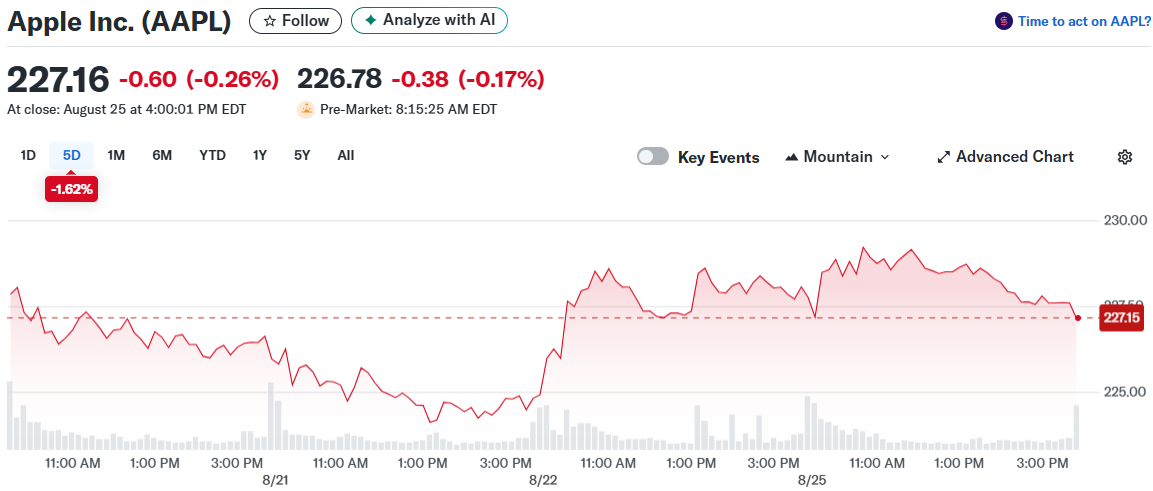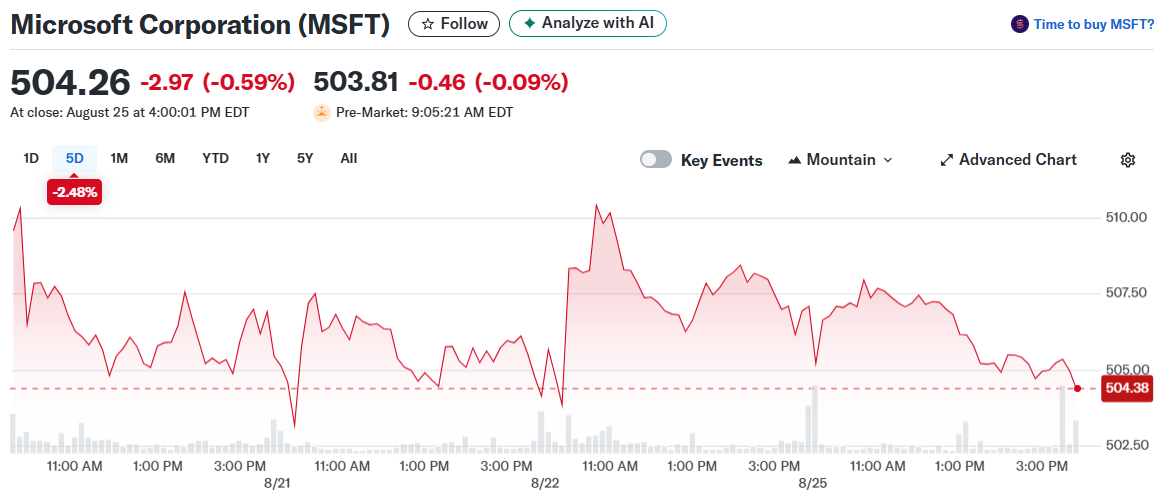TLDR
- Apple and Microsoft shares gained 688.4% and 992.5% respectively over the past 10 years, both outperforming the S&P 500
- Apple’s iPhone generated $44.6 billion in Q3 sales, representing 47% of total revenue with 13.5% year-over-year growth
- Microsoft’s three business segments all performed well, with total Q4 revenue growing 17% year-over-year
- Microsoft’s Azure cloud services grew 39% in Q4 and holds 20% market share behind Amazon’s 30%
- Microsoft stock gained 19.7% year-to-date while Apple shares declined 10.3% through August 20
Both Apple and Microsoft continue to demonstrate their staying power as technology leaders nearly five decades after their founding in the mid-1970s. The two companies have delivered exceptional returns to investors over the past decade, though recent performance shows diverging paths.
Apple’s business remains heavily dependent on iPhone sales, which generated $44.6 billion in the company’s fiscal third quarter ending June 28. This represents over 47% of Apple’s total revenue for the period, with sales growing 13.5% compared to the previous year.

The iPhone maintains a competitive position in the global smartphone market with a 19% market share in the first calendar quarter of 2025. Samsung Electronics holds the leading position at 20% market share, keeping the competition tight between the two manufacturers.
Apple’s services division continues to show strong performance, generating $27.4 billion in third-quarter sales. This represents 13% growth year-over-year and maintains much higher profit margins than hardware products.
The services segment achieved a gross margin of 75.6% in the third quarter, expanding by 1.6 percentage points. This division includes advertising, product support, the App Store, and payment services.
iPhone Dependence Creates Challenges
Apple faces ongoing challenges in product innovation beyond the iPhone. The company canceled its decade-long self-driving electric car project in 2024 after years of development.
The Vision Pro headset, priced at $3,500, launched in early 2024 but has received limited attention from management in recent communications. Early generative artificial intelligence products from Apple have not gained strong user adoption.
Microsoft operates across three main business segments that each contribute different revenue portions. Productivity and business processes account for 43% of fourth-quarter revenue, intelligent cloud represents 39%, and more personal computing makes up 18%.

The company’s fiscal fourth quarter showed broad-based growth with revenue increasing 17% year-over-year when adjusted for foreign currency effects. Operating income grew 22% during the same period, with Microsoft’s fiscal year ending June 30.
Cloud Services Drive Microsoft Growth
Azure and other cloud services represent a key growth driver for Microsoft, with sales increasing 39% in the fourth quarter. The cloud division generated more than $75 billion in annual revenue.
Microsoft holds a 20% market share in cloud services, trailing only Amazon Web Services at 30%. The cloud market remains dominated by large companies with resources to build extensive data center infrastructure.
Multiple Microsoft products showed double-digit revenue growth in the fourth quarter. These included Azure cloud services, Microsoft 365 for both consumers and businesses, server products, and search and news services.
Stock performance for the two companies has moved in opposite directions during 2025. Microsoft shares gained 19.7% year-to-date through August 20, outperforming the S&P 500’s 8.4% gain.
Apple shares declined 10.3% during the same period, reflecting investor concerns about growth prospects. Both companies trade at premium valuations compared to the broader market.
Microsoft’s stock trades at a price-to-earnings ratio of 37, while Apple’s P/E multiple stands at 34. The S&P 500 index trades at a P/E ratio of 30 for comparison.
Microsoft’s diverse product portfolio spans consumer and business markets through Office 365, LinkedIn, Windows, Xbox gaming, and cloud infrastructure services. This diversification provides multiple revenue streams compared to Apple’s iPhone-centric model.


